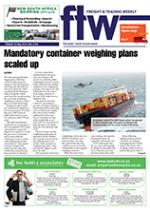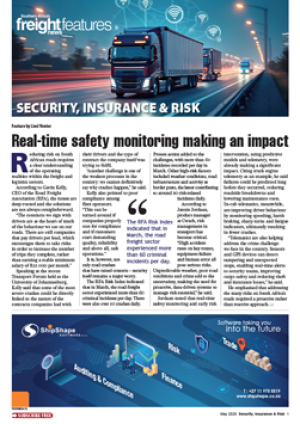Despite a lot of talk about
moving cargo from road
to rail, not much is really
happening at ground level.
Mike Walwyn, director of
Seaboard Maritime Services
and chairman of the Cape
Port Liaison Forum, says
while more cargo is moving
on rail now compared to
the past few
years, it is
debatable
how much
market share
rail has
gained in real
terms.
“We have
seen a slight
increase in
the volume
of containers
on rail, but at
the same time
the overall
volumes being moved has
increased, so it could be
argued they are moving
more containers because
there are more containers.”
He said in Cape Town
the volume of containers
moving by rail remained
insignificant.
“We are talking only
about 2 or 3% of the total
volume and most of that is
for an automotive contract.”
Cape Town Terminals
manager Brenda Magqwaka
earlier told FTW that
requests for increased rail
capacity at the Cape Town
Port remained few and far
between with
demand for
rail very low.
According
to Dave
Watts,
maritime
director for
the South
African
Association
of Freight
Forwarders
(Saaff), the
country was
not really
progressing in its attempt
to move cargo from road
to rail.
“There are various
reasons for that, amongst
them a very real capacity
constraint,” he said. “Rail
needs serious infrastructure
development.”
And, say the experts,
a rail strategy developed
in conjunction with the
industry needs to be in
place before any major
inroads will be made in the
way cargo is moved in South
Africa.
Government remains
committed to easing the
country’s dependence on
road transport and through
its New Growth Path and
National Infrastructure
Plan has
given
a clear
indication
of the ever-growing role
of rail.
Years of underinvestment
is being
addressed with Transnet
Freight Rail (TFR)
investing at least R201
billion in its infrastructure
and maintenance over
the next few years, while
the Strategic Integrated
Projects (SIPS) identified
by government also have
a major rail emphasis.
These projects, aimed at
upgrading the
country’s
infrastructure, saw rail
specifically identified
as a strategic area of
development to improve
the country’s transport
efficiency.
Walwyn says this is
commendable and the
ultimate goal of seeing
fewer trucks and more
trains is one that should be
welcomed across the board
by industry.
“We should, however,
have realistic expectations
around it. It is not
going to happen
quickly.”
INSERT & CAPTION
We are talking only
about 2 or 3% of the
total volume and
most of that is for an
automotive contract.
– Mike Walwyn
INSERT
A rail strategy
developed in
conjunction with the
industry needs to be
in place before any
major inroads will
be made in the way
cargo is moved in
South Africa.

